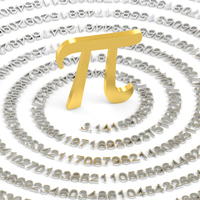March 14 is a special day on the calendars of mathematicians, math teachers, and math students around the world. Why? It’s Pi Day! An important thing to know about Pi Day is that it’s recognized on 3/14—representing 3.14, the first three constants of the famous irrational number—every year.
You don’t have to be a math fan to celebrate…but it certainly helps! Here’s what to know about Pi Day:
History of Pi Day
Physicist Larry Shaw of the San Francisco Exploratorium is responsible for celebrating the first-ever Pi Day in 1988 with his co-workers. Since then, Pi Day has turned into a national phenomenon celebrated by people everywhere.
Interestingly enough, Pi Day is also physicist Albert Einstein’s birthday.
[RELATED: What to Know About College-Level Math]
Some facts about Pi
Pi is an irrational, never-ending number represented by the symbol, π. The first 31 digits of pi are: 3.1415926535897932384626433832795.
Pi is officially defined as “the ratio of a circle’s circumference to its diameter.” A circle’s diameter is the distance across it from one edge to the other while its circumference is the distance around the whole circle. Pi is considered a constant number because Pi is the same for all circles, regardless of their size.
Pi is used in several geometry formulas involving circles. Most often, it is used to find the area of a circle (Area = Pi multiplied by the circle’s radius squared, or A = πr2) or the volume of a cylinder (Volume = Pi multiplied by the cylinder’s radius squared, multiplied by its height, or V = πr2h).
[RELATED: Study Strategies for Math]
Mathematicians been using Pi for about 4,000 years. Originally, the ancient Babylonians would calculate the area of a circle by taking three times the square of its radius, giving Pi a value of 3. As time went on, the Babylonians and other civilizations all over the world began making closer approximations of Pi, based largely off of their astronomical measurements. Pi’s official symbol came from the Greek letter, π, in the 1700s.

How to celebrate Pi Day
Students and teachers at schools and colleges across the world hold Pi Day celebrations that often include eating at least one type of pi(e)—whether it’s made of fruit, chocolate, or pizza—as well as telling Pi jokes and discussing Pi history.
You don’t have to be a student to celebrate Pi Day, however! Some organizations have big events open to the public on March 14. These include the San Francisco Exploratorium’s afternoon festival of all things Pi and Princeton, New Jersey’s Pi Day Princeton celebration, a whole weekend of Pi Day events.
[RELATED: What are the High School Math Courses?]
Turns out, Pi Day is also a great day to shop for, well, pies! Many eateries—mostly national pizza chains—are offering food for just $3.14, or with BOGO deals. These include:
-
Blaze Pizza: build your own pizza for $3.14
-
Pi Pizzeria: get a free large pizza if you’re born on March 14 and have ID to prove it, or buy a large pizza and get another for just $3.14
-
Urban Bricks Pizza: get pizzas for $3.14
-
Villa Italian Kitchen: get full-size Neapolitan cheese pizzas for $3.14 each, with coupon (available on their website)
Any topics you want to know more about? Let us know! The Varsity Tutors Blog editors love hearing your feedback and opinions. Feel free to email us at blog@varsitytutors.com.

